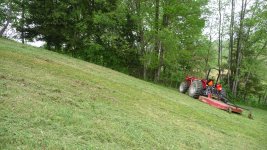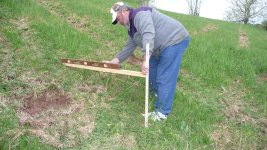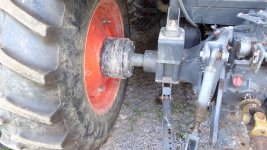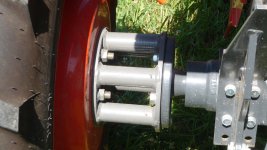JWR
Elite Member
- Joined
- Apr 19, 2011
- Messages
- 3,990
- Location
- So MD / WV
- Tractor
- MF 2660 LP, 3 Kubota B2150, Kubota BX2200, MH Pacer, Gravely 5660, etc.
Land is full of 8-degree slopes with a few steeper ones at 12-degrees.
If I take my time and am not an idiot, would that slope scare any of you?
Answer: NO, not at all.
=================================================================
I encounter steep ground and variations of it every year bush hogging. Decades doing that.
Several comments:
1) I disagree with SDT. Leave the bucket on and run with it low but tip up to avoid snags. You are better ballasted that way and the bucket lowers your c.g. a little. AND traction is better. Mine is definitely more stable with the bucket ON.
2) As Scotty pointed out in a previous post there is a lot of confusion in degrees versus % slope. Here is a graph to clarify that. Being an old helicopter pilot you have seen similar charts before I imagine.
View attachment 550845
This is a high 30's% slope near 40%.

This is a 40% slope.

3) With your 8 to 12 degree slopes there is very little worry unless you stumble into a big hole with the lower rear wheel, etc. 12 degrees is about a 20% slope which is still pretty mild. I mow 40% slopes many times every season without any problems. My limit is about 50%. Anything over 50% does not need to be mowed by me. A 40% slope can safely be mowed with my MF2660 tractor going across it but a 50% slope is too much cross wise for me. My rear tires are set 8' apart at outer edges and it is a low profile (lower c.g.) tractor. I hasten to say I ALWAYS mow steep slopes up/down unless I am boxed in to some momentary cross slope situation. There is no such thing as too much safety margin.
By the way, I know where every ground hog hole and sink hole is in my farm having been over every inch of it since I was in grade school. You need to get very familiar with yours.
4) You may want to hunt up a You Tube video from Penn State Univ. They run a remote control Ford tractor around a hillside every August in their Ag Progress Show and purposely upset it by hitting a hole with the low side rear wheel. I've watched it in person a couple of times and it is impressive.
5) I know a lot of Orange folks don't like me saying this, but the Japanese have thick skulls -- they just cannot seem to understand that many of us operate on steep ground. Most Kubota mid size tractors (40-70hp size) simply do not have the ability to spread the rear wheels apart that they should have. My pasture renter uses an M6040 with 6" spacers on each side and were very uncomfortable until those were installed. The same is true with an L3040 they use. These picts show the spacers installed.
 and
and 
6) Unless you have some compelling reason not to, absolutely run those rear wheels of yours out as far as you possibly can. Try it and gain your own experience of course. If you have any discomfort, add 6" spacers on each side (like the M6040 above) and that will give you a huge margin of comfort on steep hillsides.
If I take my time and am not an idiot, would that slope scare any of you?
Answer: NO, not at all.
=================================================================
I encounter steep ground and variations of it every year bush hogging. Decades doing that.
Several comments:
1) I disagree with SDT. Leave the bucket on and run with it low but tip up to avoid snags. You are better ballasted that way and the bucket lowers your c.g. a little. AND traction is better. Mine is definitely more stable with the bucket ON.
2) As Scotty pointed out in a previous post there is a lot of confusion in degrees versus % slope. Here is a graph to clarify that. Being an old helicopter pilot you have seen similar charts before I imagine.
View attachment 550845
This is a high 30's% slope near 40%.

This is a 40% slope.

3) With your 8 to 12 degree slopes there is very little worry unless you stumble into a big hole with the lower rear wheel, etc. 12 degrees is about a 20% slope which is still pretty mild. I mow 40% slopes many times every season without any problems. My limit is about 50%. Anything over 50% does not need to be mowed by me. A 40% slope can safely be mowed with my MF2660 tractor going across it but a 50% slope is too much cross wise for me. My rear tires are set 8' apart at outer edges and it is a low profile (lower c.g.) tractor. I hasten to say I ALWAYS mow steep slopes up/down unless I am boxed in to some momentary cross slope situation. There is no such thing as too much safety margin.
By the way, I know where every ground hog hole and sink hole is in my farm having been over every inch of it since I was in grade school. You need to get very familiar with yours.
4) You may want to hunt up a You Tube video from Penn State Univ. They run a remote control Ford tractor around a hillside every August in their Ag Progress Show and purposely upset it by hitting a hole with the low side rear wheel. I've watched it in person a couple of times and it is impressive.
5) I know a lot of Orange folks don't like me saying this, but the Japanese have thick skulls -- they just cannot seem to understand that many of us operate on steep ground. Most Kubota mid size tractors (40-70hp size) simply do not have the ability to spread the rear wheels apart that they should have. My pasture renter uses an M6040 with 6" spacers on each side and were very uncomfortable until those were installed. The same is true with an L3040 they use. These picts show the spacers installed.
 and
and 
6) Unless you have some compelling reason not to, absolutely run those rear wheels of yours out as far as you possibly can. Try it and gain your own experience of course. If you have any discomfort, add 6" spacers on each side (like the M6040 above) and that will give you a huge margin of comfort on steep hillsides.
Last edited:
